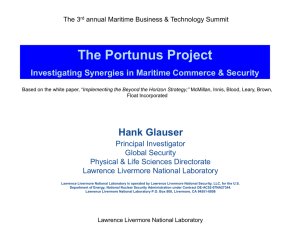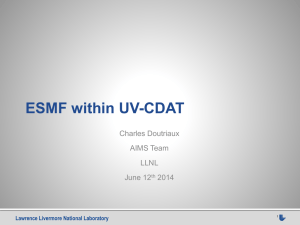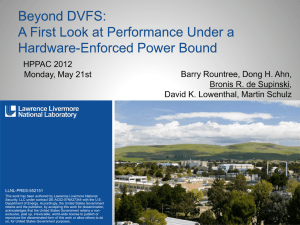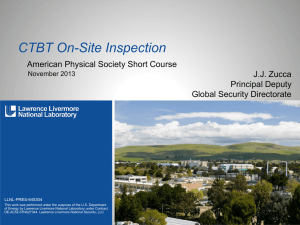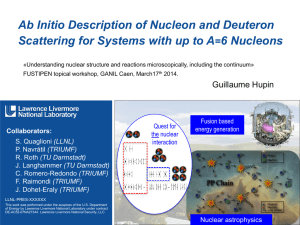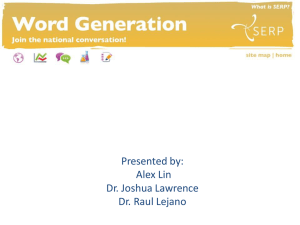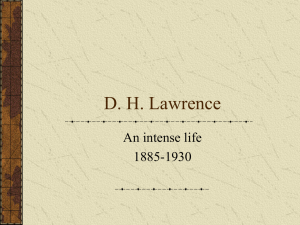Toward a Fundamental Understanding of Nuclear Reactions and
advertisement
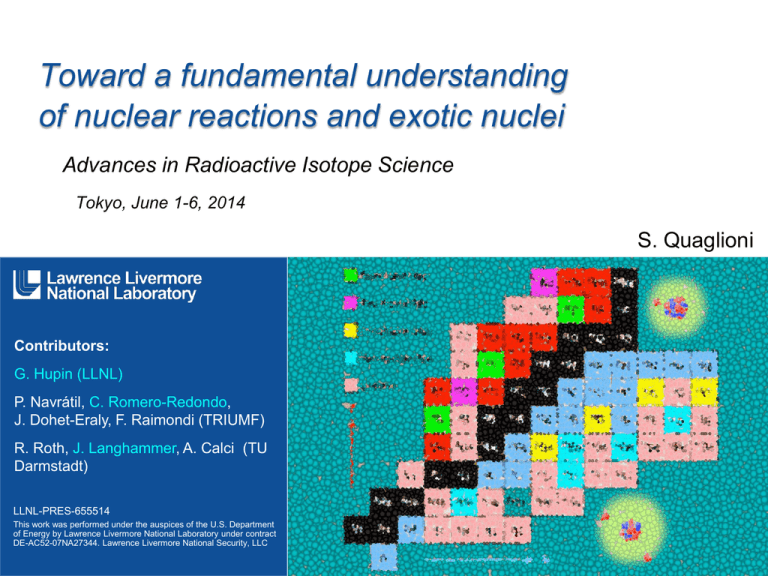
Toward a fundamental understanding of nuclear reactions and exotic nuclei Advances in Radioactive Isotope Science Tokyo, June 1-6, 2014 S. Quaglioni Contributors: G. Hupin (LLNL) P. Navrátil, C. Romero-Redondo, J. Dohet-Eraly, F. Raimondi (TRIUMF) R. Roth, J. Langhammer, A. Calci (TU Darmstadt) LLNL-PRES-655514 This work was performed under the auspices of the U.S. Department of Energy by Lawrence Livermore National Laboratory under contract DE-AC52-07NA27344. Lawrence Livermore National Security, LLC Light exotic nuclei offer an exciting opportunity to test our understanding of the interactions among nucleons But this is not an easy goal … Challenging for experiment • Short half lives or unbound • Minute production cross sections Challenging for theory • Low (multi-)particle emission thresholds or unbound • Bound, resonant and scattering states may be strongly coupled Need advanced experimental techniques and ab initio nuclear theory including the continuum Lawrence Livermore National Laboratory LLNL-PRES-655514 2 To develop such an ab initio nuclear theory we: 1) Start with accurate nuclear forces (and currents) NN force Two- plus three-nucleon (NN+3N) forces from chiral effective field theory (EFT) • NN potential at N3LO (by Entem & Machleidt) • 3N force at N2LO (in the local form by Navratil) • Guided by quantum chormodynamics (QCD) • Entirely constrained in the 2- and 3-nucleon systems NNN force NNNN force Q0 LO Q2 NLO Q3 N2LO Q4 N3LO + ... + ... + ... Worked out by Van Kolck, Keiser, Meissner, Epelbaum, Machleidt, ... Lawrence Livermore National Laboratory LLNL-PRES-655514 3 2) ‘Soften’ the interactions using unitary transformations Similarity Renormalization Group (SRG) method Phys. Rev. Lett. 103, 082501 (2009) H l = Ul H l=¥Ul+ Þ Unitary transformations dH l é = ëh ( l ), H l ùû dl Flow parameter SRG NN+3N Bare NN+3N Decouples low and high momenta l = 20 fm-1 Induces 3-body (& higher-body) forces l = 2 fm-1 For the lightest nuclei SRG-evolved NN+3N forces allow to obtain unitarily equivalent results in much smaller model spaces Lawrence Livermore National Laboratory LLNL-PRES-655514 4 3) Solve the many-body problem using a unified approach to nuclear bound and continuum states Ab initio no-core shell model (NCSM) … • Bound states, narrow resonances • Clusters’ structure, short range N N max 1 … with resonating-group method (RGM) • Bound & scattering states, reactions • Dynamics between clusters, long range r Most efficient: ab initio no-core shell model with continuum (NCSMC) NCSM/RGM channel states NCSM eigenstates Y ( A) = å cl l , l + å ò dr g v (r ) Aˆn n r ( A - a) ( a) , n Unknowns Lawrence Livermore National Laboratory LLNL-PRES-655514 5 Discrete and continuous variational amplitudes are determined by solving the coupled NCSMC equations ( A) ElNCSM dll¢ æ H ç NCSM ç h è r' Ù H An h H RGM Ù Ù An ¢ H An r ( A) dll¢ öæ æ 1 ö ÷ç c ÷ = E ç NCSM ÷ç g ÷ ç g è ø ø è r r' r Ù An g N RGM Ù Ù An ¢ An öæ ö c ÷ç ÷÷ ç ÷ g ø øè r Scattering matrix (and observables) from matching solutions to known asymptotic with microscopic R-matrix on Lagrange mesh Lawrence Livermore National Laboratory LLNL-PRES-655514 6 7He: An ideal system to showcase new achievements made possible by the ab initio NCSM with continuum is unbound – cannot be reasonably described with NCSM 7He 6He • n+6He Ground State Resonance core polarization important n+6He NCSM/RGM calc. with more than few 6He states difficult! NCSMC calculation: • SRG-N3LO NN with l = 2.02 fm-1 • Nmax= 12, ħW = 16 MeV • Up to 3 6He and 4 7He states Convergence with number of 6He eigenstates 7He states compensate for missing higher 6He excitations Lawrence Livermore National Laboratory S. Baroni, P. Navratil, and S. Quaglioni, Phys. Rev. Lett. 110, 022505 (2013); Phys. Rev. C 87, 034326 (2013) LLNL-PRES-655514 7 7He: An ideal system to showcase new achievements made possible by the ab initio NCSM with continuum NCSMC yields 3/2- g.s. and 5/2resonances close to experiment Is there a low-lying 1/2- state? n+6He Low-Lying Continuum ? Expt. Results obtained with NCSMC approach Low-lying 1/2- state not supported by our calculation Lawrence Livermore National Laboratory S. Baroni, P. Navratil, and S. Quaglioni, Phys. Rev. Lett. 110, 022505 (2013); Phys. Rev. C 87, 034326 (2013) LLNL-PRES-655514 8 picture?The unbound 5He nucleus is an excellent testing ground 5He SRG-evolved chiral NN+3N with l = 2.0 fm-1 resonances sensitive to strength of spin-orbit force • n+4He Scattering Phase Shifts NCSMC Both Induced and initial 3N forces are included NCSMC calculation: + • Nmax = 13 model space • Up to 14 5He and 7 4He states • Excellent convergence Convergence with number of 4He eigenstates G. Hupin, S. Quaglioni, and P. Navratil, in preparation Lawrence Livermore National Laboratory LLNL-PRES-655514 9 picture?The unbound 5He nucleus is an excellent testing ground Are the 5He states really needed to accurately describe the n+4He continuum? n+4He Scattering Phase Shifts NCSM/RGM NCSM/RGM calculation: • Nmax = 13 model space • Up to first 7 states of 4He • Not sufficient! 4He core polarization is non negligible. 5He states essential to describe resonances Lawrence Livermore National Laboratory Convergence with number of 4He eigenstates G. Hupin, J. Langhammer, P. Navratil, S. Quaglioni, A. Calci, And R. Roth, Phys. Rev. C 88, 054622 (2013) LLNL-PRES-655514 10 Are 3N forces necessary to achieve a complete picture?The unbound 5He nucleus is an excellent testing ground 3N force enhances 1/2- 3/2- splitting; essential at low energies! Elastic scattering of neutrons on 4He NN+3N NN (with ind. terms) NN+NNN NCSMC x Expt. G. Hupin, S. Quaglioni, and P. Navratil, in preparation Lawrence Livermore National Laboratory LLNL-PRES-655514 11 9Be: Does the 3N force deteriorate the description of the low-lying spectrum? No, need to include the continuum! 9Be vs. 9Be+n-8Be(0+,2+) calculations: preliminary Nmax=10 results Expt. E E Expt. n+8Be n+8Be J. Langhammer, P. Navratil, R. Roth et al., in progress Lawrence Livermore National Laboratory LLNL-PRES-655514 12 What about scattering with composite projectiles? angular differential cross section [mb/sr] d+4Hed+4He with & without inclusion of: 6Li states / 3N forces 1000 Expt. 4 d+ He 4 6 (d+ He) + Li preliminary 100 preliminary NN-only l = 2.0 fm-1 Ed = 2.935 MeV 10 0 30 60 90 120 150 (d+4He) + 6Li 180 center-of-mass angle [deg] (d,N) transfer and deuterium scattering on p-shell nuclei underway G. Hupin, S. Quaglioni, and P. Navratil, in progress Lawrence Livermore National Laboratory LLNL-PRES-655514 13 We want to describe also systems for which the lowest threshold for particle decay is of the 3-body nature Borromean halo nuclei 11Li • 6He (= 4He + n + n ) • 6Be (= a + p + p ) • 11Li (= 9Li + n + n ) • 14Be (= 12Be + n + n ) • … n 4He S. Quaglioni, C. Romero-Redondo, and P. Navratil, Phys. Rev. C 88, 034320 (2013) Lawrence Livermore National Laboratory separation (fm) n Probability density of 6He g.s. Probability density of 6He g.s. 4He-neutrons Constituents do not bind in pairs! 208Pb neutron’s separation (fm) LLNL-PRES-655514 14 Experimental picture for the excited states of 6He Recent expt. @SPIRAL, GANIL: PLB 718 (2012) 441 8He(p,3H) Soft dipole mode? Lawrence Livermore National Laboratory LLNL-PRES-655514 15 Can we gain insight from an ab initio calculation? Need to treat 3-cluster continuum: 4He(g.s.)+n+n C. Romero-Redondo, S. Quaglioni, and P. Navratil, arXiv:1404.1960 Lawrence Livermore National Laboratory LLNL-PRES-655514 16 Can we gain insight from an ab initio calculation? Need to treat 3-cluster continuum: 4He(g.s.)+n+n Scattering phase shifts Energy spectrum of states new Present results do not support a three-body soft-dipole resonance C. Romero-Redondo, S. Quaglioni, and P. Navratil, arXiv:1404.1960 Lawrence Livermore National Laboratory LLNL-PRES-655514 17 The ab initio description of light dripline nuclei with QCD-guided NN+3N forces is now becoming possible The NCSMC is an efficient ab initio theory including the continuum • NCSM eigenstates short- to medium-range A-body structure • NCSM/RGM cluster states scattering physics of the system New developments • 3N force in nucleon- and deuterium-nucleus scattering • Three clusters in the continuum • Many I have not presented see J. Dohet-Eraly, PS2-B010 Even more exciting work ahead! Lawrence Livermore National Laboratory G. Hupin, S. Quaglioni, and P. Navratil, in preparation LLNL-PRES-655514 18 Extras Lawrence Livermore National Laboratory LLNL-PRES-655514 19 ✓ ◆✓Is◆this ◆ ◆ ✓ ✓basis ◆✓ ◆ ◆problem? ✓ NCSM ✓ ✓ NCSM calculations. a HO size Is Is ¯ HN h calculations. Is this a HO basis size c c 1 g ¯ c c ◆problem? ¯ CSM HN CSM h 1 g ¯ = E= E − − thish¯this anh¯interaction dependent problem? χ ¯ g ¯problem? 1 ¯ χ − − N HN an interaction dependent χ ¯ g ¯ 1 χ ¯ N HN Breakup threshold influences s-wave continuum Breakup thresholds impact S-waves Breakup thresholds impact S-waves Need to switch to NCSMC! Need to switch to NCSMC! 1 2 1 2 1 2 1 2 Continuum important for for other Continuum important other waves as well waves as well 8 7 +7 6 5 4 3 2 1 3/2 6 5+ 5/2 4 1/23 2 1 + 0 0 -1 -1 -2 -3 3/2 9 Be -1 SRG L =SRG 2.0 fm L = 2.0 fm + 5/2 1/2 + -hW = 20 -hMeV W = 20 MeV -W 11hW 11h + 8 8 n+ Be n+ Be preliminary preliminary -2 -3 9 N3LO NN+3NF(400) 3 Be N LO NN+3NF(400) -1 NCSM NCSM Expt Expt NCSMC NCSMC Lawrence Livermore National Laboratory 180 180 150 150 120 120 90 2 NCSMC 6 D5/2 D5/2n-8Be(08+,2NCSMC D +) ++ 9+Be 9 D9/2 9/2 n- Be(0 ,2 ) + Be 2 2 60 S1/2 60 30 30 0 0 2 4 S1/2 2 2 D3/2 D3/2 -30 -60 preliminary -60preliminary 0 -90 01 12 4 S3/2 S3/2 -30 -90 6 90 d [deg] 8 9/2 + d [deg] 9 10 + 9/2 9 Energy (MeV) Energy (MeV) 10 23 6 6 S5/2 S5/2 34 45 56 67 Ekin [MeV] Ekin [MeV] 78 89 910 10 33 LLNL-PRES-655514 33 20 Microscopic three-cluster problem Starts from: ( a2 ) 3-body channels h23 Y ( A) = å òò dx dy Gn (x, y) Aˆn Fn xy n h1,23 ( A - a23 ) ( a3 ) ya(A-a )ya(a )ya(a )d ( x - h23 ) d ( y - h1,23 ) 23 1 2 2 3 3 Projects (H - E)Y ( A) = 0 onto the channel basis: å òò dx dy éëH n v¢v ( x¢, y¢, x, y) - E N v¢v ( x¢, y¢, x, y)ùû Gv (x, y) = 0 Fn ¢x¢y¢ Aˆn ¢ HAˆn Fn xy Fn ¢x¢y¢ Aˆn ¢ Aˆn Fn xy Hamiltonian kernel Norm or Overlap kernel Lawrence Livermore National Laboratory LLNL-PRES-655514 21 This can be turned into a set of coupled-channels Schrödinger equations for the hyperradial motion y Hyperspherical Harmonic (HH) functions form a natural basis: Fn xy = åf K x y (a ) Fn K r * , r a µ¡ K ìï x = r cosa í ïî y = r sin a K L x y x, y, x y x d (r - rh ) (ah , hˆ1,23, hˆ23 ) 5/2 5/2 r rh ¢x , ¢y Then, with orthogonalization and projection over fK ¢ (a ¢) : uKv (r ) uK ¢v¢ (r¢) 5 é -1/2 -1/2 ù ¢ d r r N H N ( r , r ) = E åò ë ûn ¢n 5/2 ¢5/2 r nK r é N 1/2Gù (x, y) = r -5/2 åun K (r ) fKx y (a ) ë ûn K Lawrence Livermore National Laboratory LLNL-PRES-655514 22 These equations can be solved using R-matrix theory Internal region (r a) External region (r > a) r a 0 Expansion on a basis Bound state asymptotic behavior uKv (r ) = CKn k r K K+2 (k r ) uKv (r ) = å cnKn fn (r ) n Scattering state asymptotic behavior uKv (r ) = AKn éëH-K (k r ) dnn ¢dKK¢ - SvK,v¢K¢H+K (k r )ùû Lawrence Livermore National Laboratory LLNL-PRES-655514 23 Results for 6He ground state 6-body diagonalization vs 4He(g.s)+n+n calculation NCSM/RGM 4He(g.s.)+n+n NCSM 6-body diagonalization Ntot = N0 + Nmax Lawrence Livermore National Laboratory Differences between NCSM 6-body and NCSM/RGM 4He(g.s.)+n+n results due to core polarization Contrary to NCSM, NCSM/RGM wave function has appropriate asymptotic behavior LLNL-PRES-655514 24 Other convergence tests HH expansion c n (x, y) = Lawrence Livermore National Laboratory 1 r 5/2 K max å un K (r ) fKx y (a ) K LLNL-PRES-655514 25 Other convergence tests Extended-size HO expansion ( VA-1A 1- PˆA-1,A N ext ) µ åR ny y ( y¢)Rny y (y) ny • Sizable effects only when neutrons are in 1S0 partial wave (strong attraction) Lawrence Livermore National Laboratory LLNL-PRES-655514 26 Started with NCSM/RGM approach & gradually built up capability to describe fusion reactions with NN force Astrophysical S-factors Fusion reactions important to solar astrophysics, Big Bang nucleosynthesis, fusion research, atomic physics Good convergence with harmonic oscillator (HO) basis size (Nmax) Slower convergence with number of clusters’ eigenstates Still required for a fundamental description are also: • 3N forces • three-body dynamics Lawrence Livermore National Laboratory PLB 704, 379 (2011) 3H(d,n)4He astrophysical S-factor PRL 108, 042503 (2012) Electron screening LLNL-PRES-655514 27 We started with nucleon-nucleus collisions … PRL 107, 122502 (2011) The elastic n-3H cross section for 14 MeV neutrons, important for understanding how the fuel is assembled in an implosion at NIF, was not known precisely enough n n (14 MeV) 3H 3H d 3H 4H n+3Hn+3H cross section Corrected for target breakup En=14 MeV e We delivered evaluated data for fusion diagnostic at NIF with required 5% uncertainty. Lawrence Livermore National Laboratory Ab initio theory reduces uncertainty due to conflicting data (,,, ,) LLNL-PRES-655514 28 Similarity Renormalization Group evolution of operators* Oˆ l = Uˆ l Oˆ l=¥Uˆ *l Uˆ l = å ya (l ) ya (l = ¥) a Root-mean-square radius and total dipole strength 4He 3H *M.D. Schuster, S. Quaglioni, C.W. Johnson, E.D. Jurgenson, and P. Navratil, in preparation Lawrence Livermore National Laboratory LLNL-PRES-655514 29 Latest Publications Lawrence Livermore National Laboratory LLNL-PRES-655514 30
